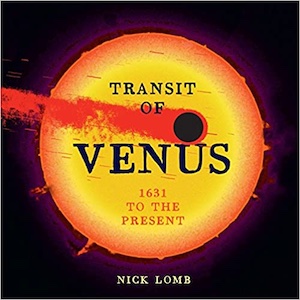By Jay M. Pasachoff
Transits of Venus, when Venus is silhouetted against the solar disk, have entranced astronomers for centuries. With the fascinating stories of Captain Cook’s voyage to Tahiti to study the 1769 transit of Venus, and of some of the hundreds of other scientific expeditions sent all over the world by many nations to study the 1761 and 1769 transits, the year 2012 will be especially exciting because it will be everyone’s last chance to see a transit of Venus, since the next pair won’t occur until the years 2117 and 2124.
Nick Lomb, with his background at Sydney Observatory in Australia and its parent Powerhouse Museum, is an ideal person to write about all aspects of transits of Venus. With a fortunate choice of Australian publisher (American publication is under negotiation at this writing), he has produced a lavishly illustrated book, Transit of Venus: 1631 to the Present, that covers the human side of transits of Venus in addition to describing the scientific interest.
That scientific interest goes back to the first prediction of a transit of Venus by Johannes Kepler in the 17th century, and the successful prediction and observation of the 1639 transit by Jeremiah Horrox in Much Hoole, England. Venus’s black silhouette on the Sun proved to be much smaller than expected, with Horrox’s discussion finally appearing in a 1662 book by Johannes Hevelius along with the latter’s discussion of the 1661 transit of Mercury.
Much of the prospective science and the many expeditions flowed from Edmond Halley’s 1716 proposal of a way to find out the distance from the Earth to the Sun, unknown at that time, by triangulating from observing points as far north and as far south on the globe as possible. More than 100 expeditions, therefore, from many countries went to observe each of the 1761 and 1769 transits. But Halley’s method was foiled by the so-called black-drop effect, described in Lomb’s book and not solved until my own work with astronomer colleague Glenn Schneider with spacecraft observations of the 1999 transit of Mercury and then applied by us to the 2004 transit of Venus, the first to occur since the 1874/1882 pairs, of which the first was expertly observed in Lomb’s home country of Australia, at the Sydney Observatory and elsewhere.
In Lomb’s book, we learn about Guillaume Le Gentil, the French astronomer who, being prevented by the British from landing in India in 1761, decided to wait the eight years for the second transit of the pair, with unhappy results. We learn about Chappe Auteroche, who gave his life, no doubt, to typhus in his zeal to observe the 1769 transit from Baja California. Lomb’s book covers so many aspects of transits that, with its clear writing and beautiful illustrations, it should be of great interest to all.
On June 5 (in the U.S.) and 6 (in Europe and Asia), everyone would be able to view the forthcoming transit of Venus over its six-hour duration, with only a simple solar filter for a dollar or so, or, even more inexpensively, with pinhole projection by holding up a piece of cardboard with a few-millimeter hole punched in it and looking down at the projected image instead of up at the hole. (Simple sunglasses won’t be safe; the solar filter needed is equivalent to about 70 pairs of ordinary sunglasses stacked up.) With the support of the Committee on Research and Exploration of the National Geographic Society, I plan to observe from the 10,000 foot volcanic crater rim of Haleakala in Hawaii with the solar observatory there, and I have arranged continental observatories such as that at Sunspot, New Mexico, and satellite observations as well. Still, the thrill of being able to see the exceedingly rare event with your unaided (though filtered) eye, as a black dot on the Sun’s surface, should lead readers of this review to learn about transits from this book and then to see one for themselves. (See also my Website at http://www.transitofvenus.info.)
Astronomer and author Jay M. Pasachoff (ΦBK, Williams College) is the director of the Hopkins Observatory and Field Memorial Professor of Astronomy at Williams College. He is a visitor in the Carnegie Observatories. Williams College is home to the Gamma of Massachusetts chapter of Phi Beta Kappa.




